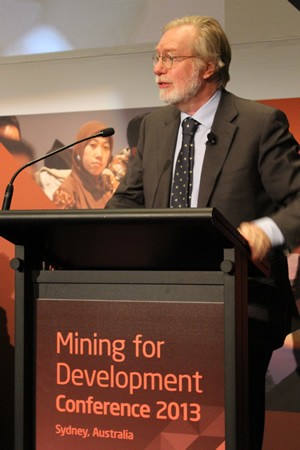Natural resource wealth presents a powerful opportunity for any country. When managed well, mining can have a transformative impact on people's lives and lift communities, regions and nations out of poverty. When managed poorly, mining can harm communities and their development prospects.
How can Australia help resource-rich developing countries to maximise the benefits of mining, protect their environment for the long-term and ensure local communities benefit?
The 2nd Annual Mining for Development Conference being held in Sydney 20-21 May is looking at how mining in developing countries can be done well, and how countries can learn from each other's experiences.
The conference is part of Australia's Mining for Development initiative worth $127 million over four years. It will provide an opportunity for governments, communities, companies, industry representatives and civil society to address one of the most important public policy challenges confronting resource-rich countries: how to ensure that mining activity contributes to sustainable economic and social development. Ensuring that the benefits of mining reach the men, women and children from where the resources are taken is critical. So is maximizing the benefits through effective use and management.
Mining generates sizeable revenues for governments and creates economic activities that stimulate broader development. In 2009, the last year for which there are figures, African natural resource exports were worth $246 billion. This is six times greater than the total official development assistance (ODA) to Africa, and seven times greater than African agricultural exports. In Afghanistan, one of the poorest countries in the world, untapped mineral wealth could exceed $1 trillion. In Papua New Guinea, the new Liquefied Natural Gas (LNG) project is forecast to increase GDP by 15 per cent in its first year of operation in 2015.
Mining can bring considerable wealth and prosperity by helping to build important infrastructure like education, health, transport and jobs. But when managed poorly, mining can harm development prospects. For example, poorly managed waste disposal can lead to the pollution of waterways and land which in turn can affect livelihoods and displace populations. Windfall revenues from mining can cause economic distortions that undermine sustainable growth and government accountability. Mining can also widen inequalities in society. We have seen mining-related conflict in Bougainville reduce living standards and set development prospects back decades.
Australia is able to draw upon lessons learned from a long history of mining. Since the gold rushes of the 1850s mining has been a major part of Australia's economic landscape. The sector grew rapidly during the iron ore and nickel booms of the 1960s and accelerated again in the current resources boom. In 2011-12, the resources sector contributed around $91 billion to Australia's GDP. Throughout this time, Australia has developed a regulatory and taxation regime to ensure the sector is internationally competitive, promotes the principles of environmental responsibility and sustainable development, and provides sufficient returns to the Australian public.
The Conference will focus on the following issues:
Gender: The degree to which women and men are able to capture the benefits of mining differs based on their respective roles in the household, community, workforce and leadership. How can we ensure that mining benefits actually make their way into the hands of women? How do we encourage more and better paid employment for women in the mining industry?
Governance: The World Bank tracks six dimensions of governance. These are: voice and accountability; political stability and absence of violence; government effectiveness; regulatory quality; rule of law; and control of corruption. Each of these dimensions is important in ensuring the benefits of development in resource rich countries are maximised and distributed in a way that enjoys wide public support. What happens when some of these dimensions of good governance are absent? How can we overcome these challenges?
Subnational governance: When conceived and supported together, effective local governance and decentralization will bring benefits, including greater economic stability, stronger local development, more targeted and relevant regulation and policies and greater community engagement. However, when decentralisation occurs but local governments have neither the power nor the capacity to manage the additional responsibilities, corruption, mismanagement and a lack of transparency can result. What happens when effective governance and decentralisation are delinked? How can the effectiveness of local governments be addressed?
Building local capacity and skills: The lack of suitably trained or skilled local workers is a major issue for the mining industry, particularly in developing countries. Individual skill development can target the public, private and community sector. Tools for improving capacity or imparting skills include scholarships, mentoring, on-the-job and formal training, and advisory support. Success in skills transfer and capacity building is hard to measure though, and it is all too easy to focus on the individual without considering the institutional context in which they work. What are some of the most effective models of skills development and transfer?
Building sustainable enterprises: Mining projects create relatively few direct jobs, but they can stimulate local economic development and help establish business enterprises that can expand beyond the mine to the broader economy. To what extent is Government and industry focused on building sustainable business enterprises that are supported by but independent from the mining industry? What can be done to ensure it happens more often?
Conflict prevention: Mining can contribute to poverty reduction but it can also contribute to or exacerbate social tensions, particularly when benefits and costs are not shared equitably. Decisions taken without the involvement of communities, or taken with the wrong parties, can lead to tensions. Economic, environmental and social impacts left unaddressed can create conflict. Revenues can be used to finance violence. What measures are being taken by government, communities and industry to prevent conflict? Is it enough? Is there enough guidance for all stakeholders on conflict or are there gaps?
More information:
Australia's Mining for Development Initiative
Video
Professor Paul Collier CBE speaks at the Mining for Development Conference

